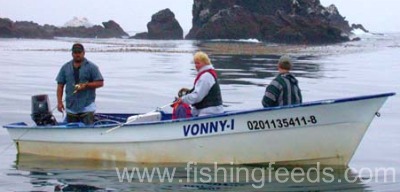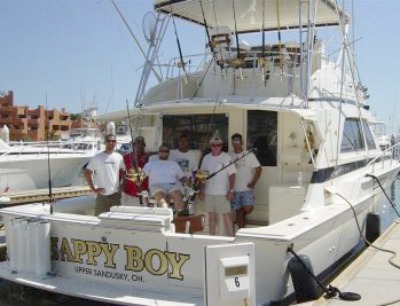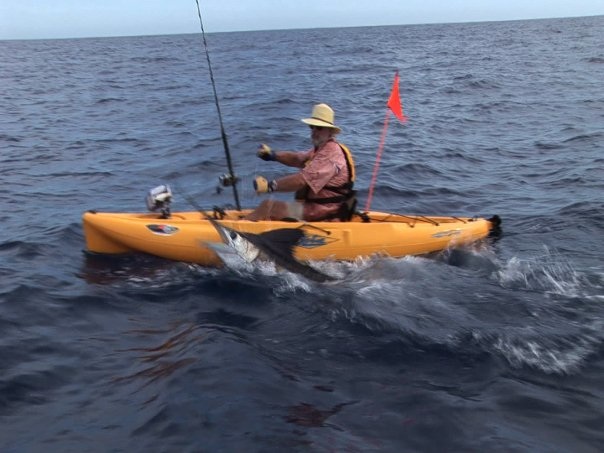Here are the latest ideas on how to get Marlin in the Boat :
Let’s start with a general overview of Marlin fishing.
I am not quite sure the total number of days that my father woke me up down in Cabo San Lucas (actually the Palmilla area is where we stayed which is closer to San Jose Del Cabo) but anyways, we would go down to where the locals were putting in their pangas, and we would get a ride out to our boat. Lets say maybe about 50-75 times over the past 15 years. Anyways, my first goal when we were getting ready to go fishing was to make sure we got to the water early enough to buy some live bait from the bait sellers down there. What would happen most of the time is we would make our way down to the water, and the bait guys would already be done for the day. As the years went on, we actually would start arriving to the water later and later to the point where we would sometimes not be getting into the water until 11:00am or later… So much of my fishing for marlin in Mexican waters has been done exclusively with lures.
But, and I will repeat this as long as I live, if you can get live bait, or even dead bait, GET IT, you will have much better luck in the long run, and the simple fact is that most of the time, when we were running several different lines/lure/bait combinations at the same time, the line that got the strike was usually one with live bait or dead bait on it.
So, the next question is what type of bait to use to catch marlin? Great question, and if you ask five different people, you may as well get five different answers. For me, the best luck I have had with striped and blue marlin has been with what the mexicans call “Caballito” which are basically small mackerel looking fish. They are usually in the 7-11 inch range, and keep relatively well in a nice circulating live bait well.
Also, a good bait to go with is live mackerel themselves.
Squid are alright to use, but they should be a last resort for drift fishing if you have other types of bait that you are using in the waters.
If you are out in search of really large blue or black marlin, small under 10lb tuna will also do the job, but of course that is when you are targeting some really big fish, and most of the time your bait will be dead since its hard to keep these guys alive for a long run.
So, how in the world do you bait the bait’s talked about above?
get your self some nice sized hooks, and try to think of the baits as needing to work themselves through the water as naturally as possible. So this means, that the mouth needs to be closed to produce less drag on the baitfish(this will allow the bait to be usable for a much longer time too.)
So, besides bait, in my mind the next most important thing about marlin fishing is keeping your eyes open at all times. Over 75% of the marlin we hooked into back in the days we saw well before they hit the line. The main reason is quite simple, marlin are big so they stand out quite a bit(especially when the water is very calm and glassy). This is not to say that marlin are always at the surface of the ocean, but when they are, they are easy to spot, since there is usually a nice fin sticking out of the water, and many times you will see two fins on one fish. This is because you are noticing their tail breaking the water and their dorsal fin at the same time.(when I was younger, I always thought it was two different fish). Now, marlin often live with others, so you may be at a luck time when you notice a whole bunch of things sticking up out of the water, we have seen six different marlin together once before. So keep your eyes open and look for the fish at all times, its going to help you spot them.
So now that you see a marlin on the surface
what do you do now?
Here is what I have found works when you see a marlin… if the fish is in back of your boat within your fishing lines, you are in good shape. As these fish are extremely fast swimmers, they can accelerate much faster than any boat can, don’t worry too much about going too fast. My father for example likes to slow the boat down once a fish is behind him. I DO NOT. If I am at the wheel when this is happening, I always speed up the boat in hopes of making the marlin think the bait is trying to get away. This usually has ended up with a strike. There have been times where we play this game with the marlin in back of the boat playing with the lures/bait for over two minutes. It feels like a very long time, but in reality it is not.
Once the fish strikes a lure/bait
now its time to set the hook well with a couple of good hard tugs. Sometimes, if you have the drag set nice and tight, it will do that on its own, and then the fish is usually off on a few minutes of incredible marlin jumps, and quite possibly it may be headed down soon afterwards.
Lures For Catching Marlin
Some of my favorite lures are the Zuker ones. We usually run one with dorado colors, the light aqua green, and also one which is more purplish in color. The purple one has been known to hook into a few wahoo from time to time as well, so be ready for that, that is the best tasting fish out there if you asked me.
Marlin are arguably the most iconic fish in sportfishing circles. Men have been known to shed a tear after an encounter with one and each fish caught is etched in an anglers memory forever.
There are four species of marlin that make up recreational catches; the blue marlin, black marlin, striped marlin and white marlin. All of the marlin species fight extremely hard and the two bigger species (blue and black marlin) can grow well over 1000 lbs!
Marlin Fishing Techniques
Marlin are an aggressive fish that respond well to teasers and plastic skirted lures trolled across the surface of the water. Most anglers consider the action of the lures on the surface far more important than color. Trolling speed is about 7-10 knots and allows the marlin boats to cover a large area.
Marlin anglers also troll natural baits such as striped tuna, bonito and Spanish mackerel. Sometimes natural baits are used in conjunction with a skirted lure to enhance the trolling action.
Marlin are also caught on live baits; either slow trolled, at drift or at anchor. Live baiting usually takes place once the marlin are located with teasers or at an area that marlin are known to frequent such as a FAD.
Marlin Tackle
Marlin are big fish and require quality rods and reels and a lever drag reel is almost essential. Most marlin anglers use a minimum of 24 kg line and 200 lbs monofilament or fluorocarbon leader. Remember that marlin will make light work of any flaw in your tackle, line or knots.
Some Fun Facts about Marlin:
Blue marlin are sexually dimorphic: adult males seldom exceed 150 kg (300 lb) whereas females may reach far larger sizes well in excess of 450 kg (1,000 lb).
The maximum size of blue (and black) marlin is often debated in both sport fishing and scientific circles. The largest sport fishing capture on record is a 1,805 lb Pacific blue marlin caught by a party of anglers in Oahu, Hawaii aboard the charter boat Coreene C skippered by Capt. Cornelius Choy (this fish often referred to as ‘Choy’s Monster’). This fish was found to have a yellowfin tuna of over 155 lbs in weight in its belly. In the Atlantic the heaviest sport fishing capture is Paulo Amorim’s 1,402 lb fish from Vitoria, Brazil.
Commercial fishermen have boated far larger specimens. The largest blue marlin brought into Tsukiji market in Tokyo supposedly weighed a massive 1,106 kg. A number of very large fish have been reported over the years, including a couple of photographs originating from Okinawa in southern Japan and Vanuatu. Commercial and sport fishermen from many other areas, both Pacific and Atlantic, have reported encounters with, and in some instances captures, of marlin thought to be in excess of 2,000 lbs, but obtaining verified weights and dimensions has proved very difficult.
A 1,000 lb (450 kg) fish, a “grander”, has historically been regarded by blue and black marlin anglers as the benchmark for a truly outstanding catch. For most marlin anglers, a 1,000 lb fish represents the fish of a lifetime. Sadly, because of ever-increasing commercial fishing effort across the world’s oceans, it seems unlikely that sport fishermen will ever break the “tonner” (2,000 lb) mark.
Diet
Blue marlin are eclectic feeders preying on a wide range of prey species and sizes. Scientific examination of blue marlin stomach contents has yielded organisms as small as miniature filefish. Common food items include tuna-like fishes, particularly skipjack tuna and frigate mackerel (also known as frigate tuna), squid, mackerel, and scad.
Of more interest to sport fishermen is the upper range of blue marlin prey size. A 72-inch white marlin has been recorded as being found in the stomach of a 448 lb blue marlin caught at Walker’s Cay in the Bahamas, and more recently, during the 2005 White Marlin Open a white marlin in the 70 lb class was found in the stomach of one of the money-winning blues. Shortbill spearfish of 30 to 40 lb have been recorded as feed items by Kona blue marlin fishermen. Yellowfin tuna of 100 lb or more have also been found in the stomachs of large blue marlin.
Fishing techniques
Blue marlin are fished for by thousands of crews from literally hundreds of ports worldwide. As may be expected, fishing styles and gear used in the pursuit of blue marlin is very diverse, depending on the size of blue marlin common to the area, the size of fish being targeted, local sea conditions, and often local tradition. However the main methods used for blue marlin can be broken down into fishing with artificial lures, rigged natural baits and live bait fishing.
Artificial lure fishing
Blue marlin are aggressive fish that respond well to the splash, bubble trail and action of a well presented artificial lure.(Just as a side note, caught way more on the live bait than on lures myself…)
Probably the most popular technique used by blue marlin crews worldwide, artificial lure fishing has spread from its Hawaiian origins throughout the world. The earliest marlin lures were carved from wood, cast in drink glasses or made from chrome bath towel pipes and skirted with rubber inner tubes or vinyl upholstery material cut into strips. Today, marlin lures are produced in a huge variety of shapes, sizes and colours, mass-produced by large manufacturers and individually crafted by small-scale custom makers.
A typical marlin lure is a small (7-8 inch), medium (10-12 inch) to large (14 inches or more) artificial with a shaped plastic or metal head to which a plastic skirt is attached. The design of the lure head, particularly its face, gives the lure its individual action when trolled through the water. Lure actions range from an active side-to-side swimming pattern to pushing water aggressively on the surface to, most commonly, tracking along in a straight line with a regular surface pop and bubble trail. Besides the shape, weight and size of the lure head, the length and thickness of skirting, the number and size of hooks and the length and size of the leader used in lure rigging all influence the action of the lure: how actively it will run and how it will respond to different sea conditions. Experienced anglers will fine tune their lures with often subtle variations to yield the desired action.
Lures are normally fished at speeds of between 7.5 to 9 knots; faster speeds in the 10 to 15 knot range are less frequently used, primarily by boats with slower cruising speeds travelling from spot to spot. These speeds allow quite substantial areas to be effectively worked in a day’s fishing. A pattern of four or more lures is trolled at varying distances behind the boat. Lures may be fished either straight from the rod tip (“flat lines”), or from outriggers.
Natural bait fishing
Rigged natural baits have been used by sport fishermen seeking blue marlin since the 1930s and are still popular in many top destinations. Throughout the eastern seaboard of the United States and in the Bahamas and Caribbean, rigged Spanish mackerel and horse ballyhoo are widely used for Atlantic blue marlin.
Rigged natural baits are sometimes combined with an artificial lure or skirt to make “skirted baits” or “bait/lure combinations”.
Live bait fishing
Live bait fishing for blue marlin normally uses small tuna species with skipjack generally considered the best choice. As trolling speed is limited by the fact that baits must be trolled slowly to remain alive, live-baiting is normally chosen where fishing areas are relatively small and easily covered. Much live-baiting in the blue marlin fishery of Kona, Hawaii, for instance, takes place near FAD (Fish Aggregation Device) buoys and in the vicinity of steep underwater ledges.
Below is a nice example of how to make a nice and easy live bait rig for marlin,dorado, tuna, wahoo etc… Simply hook the baitfish right through the cartillage like stuff near the end of the nose. This way the hook will hopefully stay there and the bait will be able to be pretty much un-affected while it swims around in the water.



